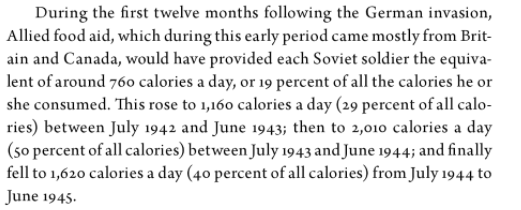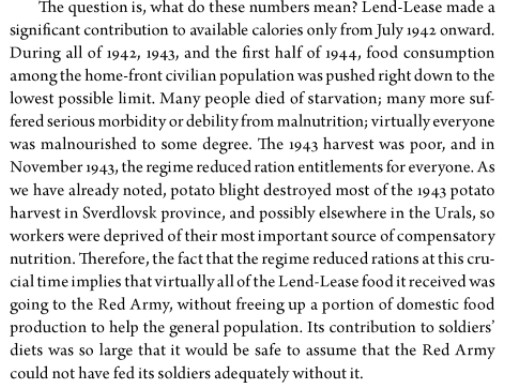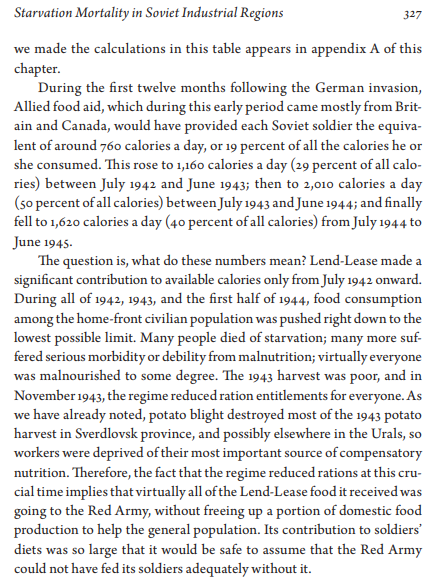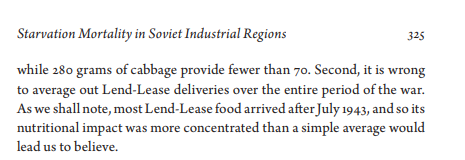History Learner wrote: ↑18 Feb 2019, 07:17
Hanny wrote: ↑17 Feb 2019, 12:58
Not yet read Hunger and War as i plan to read it side by side with The Bread of Affliction: The Food Supply in the USSR During World War II
By William Moskoff, which was the last book in read on this some time back.
But some thoughts i already have.
10/1/41-6/30/42 341,641 tons of food LL convert to kilo 309931502
7/1/42-30/6/43 1,117,517 tons of food Ll convert to kilo 1013794369
SU population in 1942 requiring food 140000000 horses in mil use 1000000
humans required 1.5 kilos or so of food per day horses 4.5 kilo of grain plus fodder.
140000000*38365 =76650000000 a year plus horses 1642500000 in mil usage.
Year 42 SU consumes 78292500000, of which LL comprised 0.4 % in 43 it rose to 1.3%
Moskoff is good, although his work is more dated and lacked access to a lot of the Soviet sources
Hunger and War got. If you don't have a JSTOR account by the way, I can PM you the chapters as PDFs if you want. As for the issue of calories, Hunger and War's research shows LL food was not going to the general population; instead it was, as near as can be discerned, going exclusively to the RKKA and at it peak constituted 50% of their food ration. Given rations in the USSR on the whole were pushed to their lowest level in late 1943 and were at critical levels from late 1942 to early/mid-1944, their overall conclusion is that it would've been impossible to sustain the Red Army without general starvation and a breakdown in production levels occurring in the attempt.
Appreciate the offer, of the pdf but i prefer to read it all. But a couple of observations untill i do.
It wont matter if the LL ( because its dry and canned goods are usfull for sending to the front) goes only to the military, SU population is the whole national, population, they all have to be fed, wherever they are,so LL contribution is compared to total food consumption, it matters not if it all went to the military. Agricultural output, was lowest in 42/3 rising dramticly thereafter in any event allowing SU to maintain 5.3 million Red army force levels in 42, rising to 6.4 in 43 rising again to 6.5 in 44.
Army rations in calories were 2,854 calories combat rations - 3.450 in 42, before rising to 3350 to 3750 calories in 44, by 45, 450,000 civialns were in reciept of military rations. Hunger and War does not use the actual calorofic content by year of SU Military rations as set down in the manuals used at the time, it prefers 4000. Humans in a military context have always required 3/4000 calories.
page 334 discusses methodology,table 5.3 List all LL sent to SU in calories.
22,874,650,250,000 caleries of LL sent over time, which supplies the Red Army for 509 days, Red Army dasilly requirement was 44,940,000,000 Red Army was at war for 1428 days, LL was in operation for 1339 days. Note it excludes feeding any animals used by the military, whose grain requirementy which is 1750 calories a day for a million horses, 1750000000 a day.
Calories required per day for 130,000,0000 at 2200 per civilian is 286,000,000,000
44,940,000,000 Military per day
286,000,000,000 Civilian per day
1750000000 horse per day
Total 332690000000 per day
LL delivered per day (22,874,650,250,000/1339) 17083383308
LL calories as a % of daily requiremnt over the period of LL, 5%.
So instead of 509 for the Red Army, its 19 days for the SU.
To strive, to seek, to find, and not to yield.




